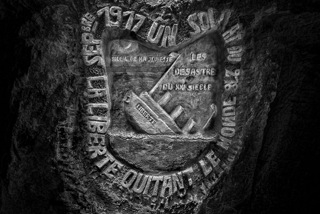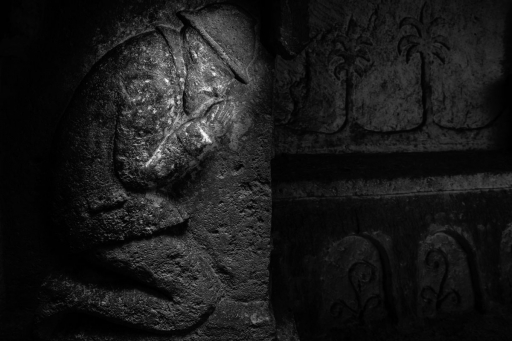Centenary News volunteer writer Christopher J. Harvie is moved by haunting images of the Western Front underground captured by the American doctor and photographer, Jeff Gusky.
Etched into the stone wall of a cavern deep below where the Western Front lay is a simple, yet profoundly evocative image of a soldier kneeling in prayer. This carving, and many others like it, along with the relics of war left in situ, have been brought to the public through a collection of crisply detailed photographs recently released under the title “The Hidden World of World War One.”.
Shot and compiled by Jeffrey Gusky, a Texas emergency and trauma physician, the collection of over 2,000 images was compiled during six months of exploring long abandoned rock quarries in France which lie beneath the land fought over a century ago.
Dr. Gusky had been granted unprecedented access to the sites by the families who own the land in exchange for his help in promoting their preservation. His previous work has already been widely acclaimed and has usually centred on the theme of humanity within war.
These quarries have been little explored and remain much as they were when they were used by soldiers of all sides in the war. Decades of disregard have created a ghostly look into a past caught in tableau, and recaptured by Dr. Gusky’s decision to photograph exclusively in black and white.

(© 2014 Jeffrey Gusky, All Rights Reserved)
Jeff Gusky states: “My mission is to two-fold; to bring these images to light through my photography and to help the landowners protect them for posterity.”
Not only do they inform us of the identity of these men and the regiments in which they served, Dr. Gusky’s pictures reveal the thoughts and expressions soldiers used to distract themselves from the horrors found above. They range from simple and simplistic markings to intensely artistic creations.
Dr. Paul Herbert, Executive Director of the First Division Museum at Cantigny, Illinois, notes: “Whether they engraved their initials or created a complete sculpture, they were expressing their identities and emotions. It is impossible not to connect with them.”
The work of photographing the caverns was demanding, and at times dangerous. Dr. Gusky was required to move himself and all his equipment in complete darkness, through narrow and steep passages where unexploded ammunition and explosives are still being found.
Public release of the pictures has gained a great deal of attention; a selection of Dr. Gusky’s photographs was featured in the August 2014 issue of National Geographic. He is also posting samples from his collection through social media on Twitter and Facebook, and hosting images on his website jeffgusky.com. His work has been lauded by military and history experts.
A published series of the collection will be forthcoming. In a brief conversation over Twitter, I asked Dr. Gusky if there were to be any public exhibitions or installations. He told me: “There aren’t any future plans at the moment, but they’ll be announced here (on Twitter) as soon as information is available.”
These works are a testament to creation amidst destruction, an act of redemption, perhaps or a hope for a better future. There is something intensely human about the desire to be remembered.
The men who sheltered in these places a century ago would have been very aware of their mortality and were compelled to create these pieces of self expression. Our obligation to never forget moves beyond the cerebral and rests with the necessity to save the objects and art they have left behind.
For more information, see Jeff Gusky’s Wikipedia page: Jeffrey Gusky – Wikipedia, the free encyclopedia
Images © 2014 Jeffrey Gusky, All Rights Reserved
Posted by CN Deputy Editor
© Author and Centenary News
